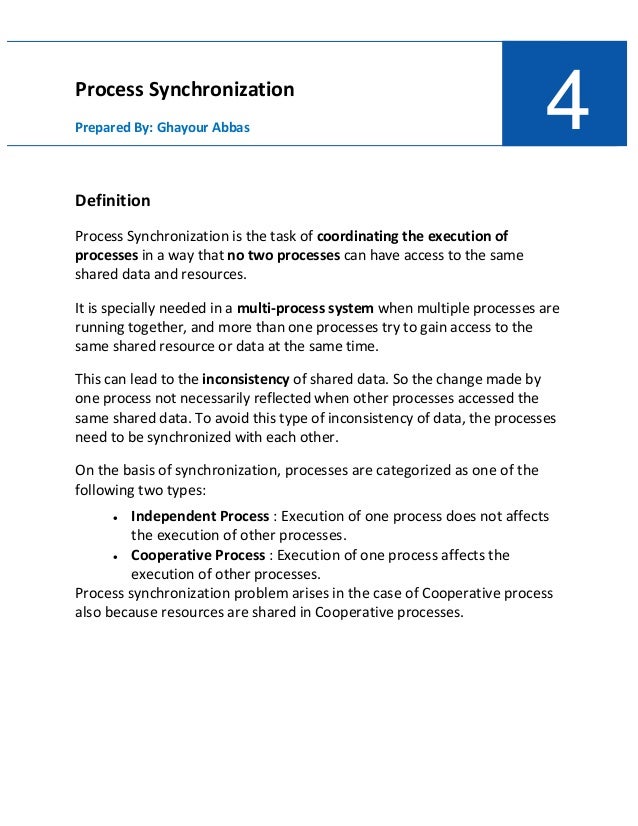
CSI-503 - 4. Process synchronization
- 1. 4 Process Synchronization Prepared By: Ghayour Abbas Definition Process Synchronization is the task of coordinating the execution of processes in a way that no two processes can have access to the same shared data and resources. It is specially needed in a multi-process system when multiple processes are running together, and more than one processes try to gain access to the same shared resource or data at the same time. This can lead to the inconsistency of shared data. So the change made by one process not necessarily reflected when other processes accessed the same shared data. To avoid this type of inconsistency of data, the processes need to be synchronized with each other. On the basis of synchronization, processes are categorized as one of the following two types: • Independent Process : Execution of one process does not affects the execution of other processes. • Cooperative Process : Execution of one process affects the execution of other processes. Process synchronization problem arises in the case of Cooperative process also because resources are shared in Cooperative processes.
- 2. How Process Synchronization Works? For Example, process A changing the data in a memory location while another process B is trying to read the data from the same memory location. There is a high probability that data read by the second process will be erroneous. Sections of a Program Here, are four essential elements of the critical section: • Entry Section: It is part of the process which decides the entry of a particular process. • Critical Section: This part allows one process to enter and modify the shared variable. • Exit Section: Exit section allows the other process that are waiting in the Entry Section, to enter into the Critical Sections. It also checks that a process that finished its execution should be removed through this Section. • Remainder Section: All other parts of the Code, which is not in Critical, Entry, and Exit Section, are known as the Remainder Section.
- 3. Race Condition When more than one processes are executing the same code or accessing the same memory or any shared variable in that condition there is a possibility that the output or the value of the shared variable is wrong so for that all the processes doing the race to say that my output is correct this condition known as a race condition. Several processes access and process the manipulations over the same data concurrently, then the outcome depends on the particular order in which the access takes place. A race condition is a situation that may occur inside a critical section. This happens when the result of multiple thread execution in the critical section differs according to the order in which the threads execute. What is Critical Section Problem? A critical section is a segment of code which can be accessed by a signal process at a specific point of time. The section consists of shared data resources that required to be accessed by other processes. • The entry to the critical section is handled by the wait() function, and it is represented as P(). • The exit from a critical section is controlled by the signal() function, represented as V(). In the critical section, only a single process can be executed. Other processes, waiting to execute their critical section, need to wait until the current process completes its execution.
- 4. Critical section is a code segment that can be accessed by only one process at a time. Critical section contains shared variables which need to be synchronized to maintain consistency of data variables. In the entry section, the process requests for entry in the Critical Section. Any solution to the critical section problem must satisfy three requirements: • Mutual Exclusion: Mutual Exclusion is a special type of binary semaphore which is used for controlling access to the shared resource. It includes a priority inheritance mechanism to avoid extended priority inversion problems. Not more than one process can execute in its critical section at one time. • Progress: This solution is used when no one is in the critical section, and someone wants in. Then those processes not in their reminder section should decide who should go in, in a finite time. • Bound Waiting: When a process makes a request for getting into critical section, there is a specific limit about number of processes can get into their critical section. So, when the limit is reached, the system must allow request to the process to get into its critical section.